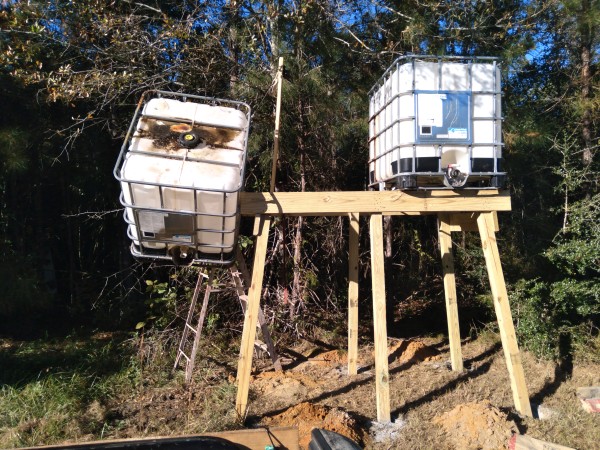Cousin Gunner, back in the old country, has an interesting power situation. Apparently, the Danes and the Germans are interconnected and when the wind blows a lot the Germans pay–PAY!– the Danes to use the excess wind power. Just thinking, if Kuzin Gunner had a battery backup system, he could set it to charge during the free hours and use it as needed, at no cost.
On the other hand, if the Germans had more storage they could mete out the power at a more constant rate and not pay people to take it. With renewable energy the big deal is the storage and the big problem is that we don’t have enough of it. It’s expensive! I don’t know about you, but batteries come first to mind, but while battery R&D is progressing like mad, so are other technologies. A while back I brought up the compressed air power system that used to run Paris. That would be an excellent way to store excess wind or solar power and distribute it, if the system still ran.
Gravity systems are becoming a big deal, too. It started at abandoned mines, where a weight could be raised or lowered like the weights in a tall case (grandfather) clock. These have been refined and now there are gravity systems that look like office buildings to blend in.
Pumped hydro is a big deal, too. When you’ve excess power, use it to put some water into a tank or pond on the hill and during slack times, let it run back down through a turbine. I’m not sure which of these storage technologies is the most efficient or cost effective, but I am going with a sort of pumped hydro at my house. This will upgrade the water system at my farm and provide backup and extra capacity for what I now have. The system has evolved over the years, but has started the water up the hill with a water-powered ram pump. This is a curious relic of the 18th century, using the observations of an English plumber and a Frenchman who launched farm animals in a hot air balloon.
There have been several pumps over the years, but the one that works best is a Rife that is just a bit over 100 years old and working well. It pumped into a pressure tank with troublesome pressure regulation, but now ultimately pumps into an elevated tank about a half mile away. That storage head compresses the water into an ordinary well tank at the house. (Stay with me…I’m heading toward the solar bit.) Since building the tank on the hill arrangement, we’ve had adequate pressure for the upstairs shower, more consistent pressure, more capacity and reserve capacity should the pump not work. Nothing breaks with excess pressure…the tank just overflows.

Here is the thing with a ram pump: It takes a lot of water to pump a little. The spring is 10 feet above the pump and the tank is a bit over 100 feet up the hill. 1:10. Therefore, to pump a gallon up the hill, it takes more than 10 gallons to run the pump. It isn’t perfectly efficient, so it can be a good bit more water running through. Generally, I figure around 10-15gallons per minute. Easily done, having a good spring, but a spring fills up with sand flows and leaves fall and before you know it the input screen is clogged and not passing 15 gallons per minute. Then Neal has to go down there and shovel sand and leaves—backbreaking work- –while keeping an eye out for the cottonmouth moccasin that lives in the spring. Well, I am not getting any more energetic with age, so sometimes I come up with an idea to get out of work. Some of the great inventions are born of laziness, aren’t they? Unfortunately, they also come at a cost of materials and labor. This is offset, somewhat, by the excitement of a new project. That’s where I am now. Excited about the new project. I am talking about a solar powered pump.

This has come up before. Twice. The results were not pretty because the pumps I chose both failed. I figure one could have a flaw, but when two of the same make failed, it was pointless to continue down that road. Recently I came across a pump that shows some promise and it comes with some improved technology.
Let’s talk about solar pumping in general before I get into the specifics of this project. A solar water system can use a battery or it can be batteryless. If you need to run the pump on demand at any time of the day or night you need a battery. Well, that’s if you need to run the pump at night. Do you? if you pump enough when the sun is shining and put it into a tank on the hill, the tank becomes the battery. You can flush, shower or rinse any time, night or day. Using a conventional electric battery is expensive for initial purchase, requires maintenance and it will someday need to be replaced. Also, the battery does not store water. If anything breaks in the pumping system you have no water, unless you have some in the tank on the hill. OK, so what do we need to consider about running a pump without a battery? I
If we are talking about an AC well pump like you buy at Home Depot, we are back to a battery and have to add an inverter, so let’s forget that. If you just connect a solar panel to a DC motor it will run, but may have trouble starting, especially when the sun is iffy. You can use a bigger panel, of course. (Oh, by the way, your pump voltage and the panel voltage need to be agreeable with each other.) When you have some light, but not enough to run the motor you will put a constant current through it, which may shorten the life or just kill it outright.
There is a handy gadget sometimes called a current booster that solves this problem. Essentially, the solar panel charges a capacitor to a level that triggers a comparator to turn on the connection to the motor. The capacitor gives the extra surge of current to start things moving and, with luck, there will be enough solar for the motor to continue running. If not, the comparator drops the connection and the capacitor recharges. With the right balance of components, the motor can be run slowly, but continuously. If you are sufficiently versed in electronics to make heads or tails of what I just said, a 555 timer, a few capacitors, a resistor and a big power transistor can be cobbled together to make this booster. Commercial units are available, but can be pricey.
Now to the pump I am going to try. It is all stainless construction, and the motor is oil filled and brushless. In theory, no water can get to the motor to ruin it and there are no brushes to wear out. This motor is usually referred to as a Brushless DC or BLDC, but in reality it is a 3 phase ac motor with a funky controller. This controller is where the fun begins. First off, it starts with a Maximum Power Point (MPPT) charge controller, so I can use a range of panels. If I needed the 24/7 availability, there are terminals to connect a battery. Otherwise, no battery is needed and a capacitor is charged. There are inputs to determine if the tank is full or the well is dry. If all is good to go the power will be pulsed to each of the 3 phases and the motor soft starts and the water begins to flow.
Initial thought for placement of the pump is directly into the spring. It is a short distance to a good spot for a solar panel. There is already a mount there and a cable is run. There is also a water connection to the high pressure line to the tank. Perfect… except that the pump needs to think it is perfectly vertical, in a well and surrounded by clean water. At the spring we get back to the issue of the sand flows and lots of digging. Plan B, the working plan for now, is to use the standpipe that feeds the ram pump’s drive pipe serve as the well. Even with the intake screen moderately clogged, there will be enough clear water for the pump to run flat out in bright sun. The hitch, here, is that the panel will have to be quite a distance away, which means I gotta buy some copper. Bought wire lately? They lock it up at Home Depot these days.

Ever notice how the cost of the main expensive component seems to be a minor expense in a new project. That’s ok, the delusion that my $200 pump is all it is going to cost helps me keep the project going.

In addition to the length of the wire, there will be other considerations I will delve into with you. The current draw will cause a voltage drop along the wire. Standard spools of cable may be***WILL BE***to short or too long. There are myriad types of cable to consider. Bargain hunting of surplus wire may prompt better wire for less money.
So far I have surveyed the cable route and ordered cable. We’ll go through that next time.
–Neal
